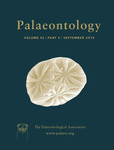Reg. Charity No. 1168330

The species of the brachiopod Gigantoproductus are giants within the Palaeozoic sedentary benthos. This presents a dilemma as living brachiopods have low‐energy lifestyles. Although brachiopod metabolic rates were probably higher during the Palaeozoic than today, the massive size reached by species of Gigantoproductus is nevertheless unusual. By examining the diet of Gigantoproductus species from the Visean (Mississippian, Carboniferous) of Derbyshire (UK), we seek to understand the mechanisms that enabled those low‐metabolism brachiopod species to become giants. Were they suspension feeders, similar to all other brachiopods, or did endosymbiosis provide a lifestyle that allowed them to have higher metabolic rates and become giants? We suggest that the answer to this conundrum may be solved by the identification of the biogeochemical signatures of symbionts, through combined analyses of the carbon and nitrogen‐isotopic compositions of the occluded organic matrix within their calcite shells. The shells are formed of substructured columnar units that are remarkably long and a few hundreds of microns wide, deemed to be mostly pristine based on multiple analyses (petrography, cathodoluminescence (CL), scanning electron microscopy (SEM), electron backscatter diffraction (EBSD), transmission electron microscopy (TEM)); they contain occluded organic fractions detected by TEM, nuclear magnetic resonance (NMR) and gas chromatography mass spectrometry (GC‐MS) analyses. We conclude that the gigantic size reached by the species of Gigantoproductus is probably the result of a mixotroph lifestyle, by which they could rely on the energy and nutrients derived both from photosymbiotic microbes and from filtered particulate food.